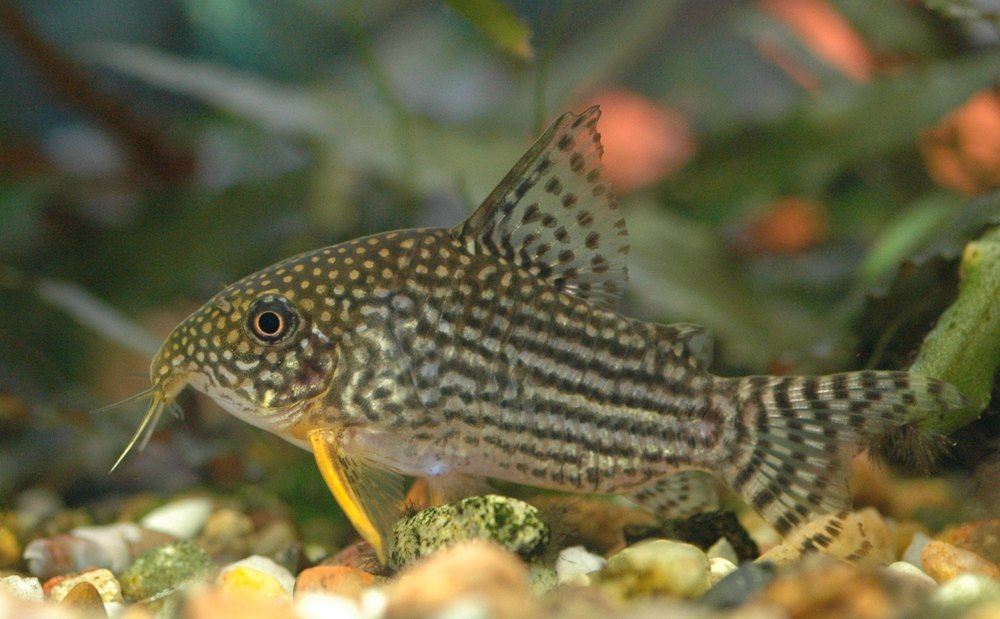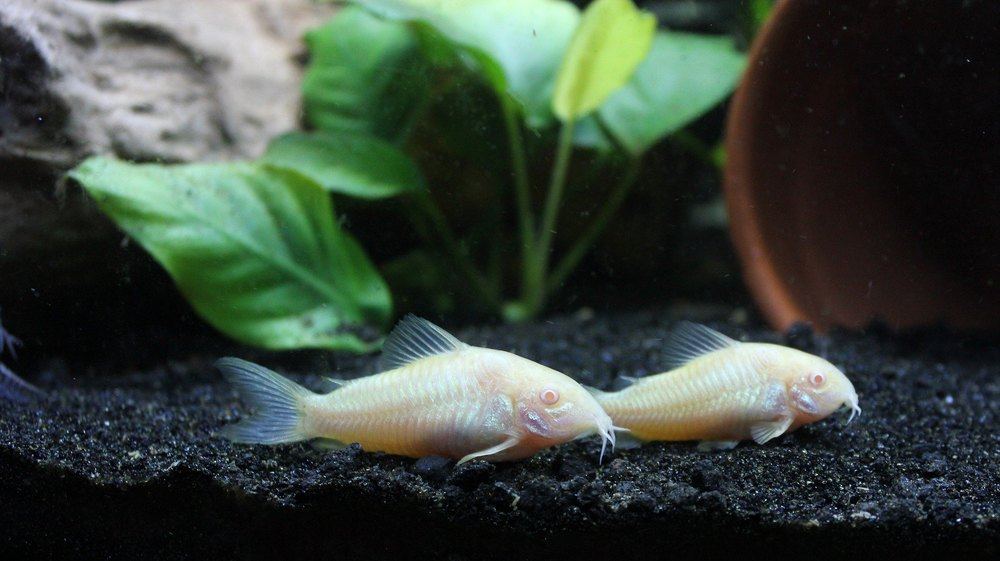If you already have an aquarium, it’s likely that you’ve considered getting a Corydoras Catfish, often just referred to as Corys.
They’re bottom feeders, very peaceful, and accepting of many tank conditions, which mean they’re perfect for beginners – especially ones fresh to mixing species in their aquarium!
As with any type of fish, it’s important to know what you’re getting into before buying a new species, so here’s the information you need for raising a Cory.
Contents
Cory Catfish Appearance
Size and Price
Corys usually grow to about four inches long at the largest, and often stay between one to two and a half inches. Their bodies are only between the size of a dime and the size of a nickel, which means they end up being pretty small overall.
Cory FIsh are usually inexpensive, costing between $1 and $6 when looking to purchase the more common species. Though the more rare you want your Corys the more the price rises. Some of the rarest Corydoras can cost around $100.
Cory lifespan varies significantly, but it does tend to be on the long side; with proper care and water conditions, it’s not uncommon for them to live up to 20 years.
However, it is very important to ensure the transfer from the store to the tank is as gentle as possible, as Corys can die shortly after being added if the shock is too great.
Corys are very peaceful, and socialize well with other species. Though most people suggest at least two or more Corys are needed, it’s best to keep Corys in groups of at least five, as they’re shoaling fish.
As long as they have tank space, they will school together, swimming and playing, which is definitely fun to watch!
If you have existing fish, remember that other relatively social ones are the best match for them, as they tend to be bullied by more aggressive species.
Sickness
Corys don’t get sick very frequently. However, there are a few more common illnesses that you should be on the lookout for.
Ich is the most common disease; it’s distinguishable by small white spots appearing on the fish’s skin and fins, comparable to salt flakes.
Usually, this is caused by quick temperature and pH changes, but can be a sign of poor-quality water, so make sure your water has been cleaned correctly. There are medications available at pet stores to easily treat the disease.
Nitrite poisoning is also a potential issue for Corys, because of their sensitivity. The fish will be sluggish or prefer to swim higher up in the tank than usual, and you will get high readings on your nitrite tests.
The nitrite levels will rise if there are too many fish in a small tank, or if the water hasn’t been changed frequently enough. In the case of nitrite poisoning, immediately change about 30% of your water and change your water more frequently until the nitrite levels go down.
There are of course other potential illnesses for Corys, but those are the most common.
Be sure to observe your fish frequently, and if you notice any differences in their behaviour, look it up right away! It could be nothing, or it could be something that needs treatment as soon as possible.
Cory Babies
If you have male and female Corys in the same aquarium, they may breed at some point; it’s not very frequent, but it’s better to be prepared just in case.
If they are interested in breeding, you’ll be able to tell because of their increased activity; the male will become much more interested in the female, and will swim around her as much as possible, while the female will clean spots on the aquarium to make places for the eggs.
The eggs will be laid in little pouches at various places on the glass, at which point you can decide whether you want to fish them out and discard them, fish them out and keep them in a special aquarium to grow, or leave them to grow in the aquarium.
Breeding Corys is not usually something that happens accidentally; people who are interested in breeding will generally keep them in a tank with special water conditions to get them interested in each other.
However, it’s not always planned, so you’ll want to keep an eye on your Corys to prevent any surprise arrivals.
Cory Catfish Care
Tank Requirements
It’s best to keep Corys in a ten-gallon tank at the minimum, but of course, the more of these creatures you have, the larger your tank should be.
The general rule of thumb is that one inch of fish should be equivalent to one gallon of water, so if your Corys are normal size, you can keep about four in a ten-gallon tank.
However, it’s always better to err on the side of caution, and you should incorporate any of your other fish into this estimate as well.
Corys are bottom feeders, which mean they’re great to help keep your existing aquarium clean!
Tank Set-up
Corys do best in preexisting aquariums, as they already have good bacteria in the water and other fish to socialize with.
However, if a Cory is your first fish, you’ll need to start a bacteria cycle. The easiest way to jump-start this process is to take a used filter pad from someone who already has fish and run it through your filter for a few hours.
You’ll need to choose a filter for yourself, but most are very user-friendly and will have manufacturer’s instructions to help you set it up.

Regular tank lighting is fine for them; Corys are diurnal, which means they are active during the day, so they need a normal cycle of light and dark.
Of course, you’ll also want to add decorations and plants to your aquarium. If you already have fish, you’ll have decorations, but you may need to change a few things.
As bottom dwellers, Corys need at least two inches of rounded gravel or soft sand substrate on the bottom of the aquarium, and they are happiest with lots of live plants in the aquarium; as timid fish, they prefer hiding places when they rest.
Water Requirements
Corys are hardy fish and keep well in many conditions, but in order to ensure they’re happy, there are a range of conditions they should stay in.
The water temperature should be 72-78 degrees Fahrenheit (22-25 Celcius), with a pH of 7.0 to 7.8.
Nitrite levels are incredibly important for Corys, so measure your water every so often to make sure the levels are at 0ppm.
You can find aquarium thermometers, pH meters, and nitrite checkers at your local pet supply store.
Tank Maintenance
It’s very important to change the water frequently. At the very least, you should be changing approximately 30% of the water every five days, though some people recommend changing 10% every day.
Changing your water at least every few days will keep the nitrate levels low, and you’ll be able to keep your Corys as happy as possible.
Lastly, make sure you keep your aquarium covered. Though it’s not always important for other species, Corys like to move up to the top of the aquarium and take a “breath” of water or eat little bits of food.
They like to dart from the bottom to the top and back down, so keeping your aquarium covered will make sure they’re able to do that without jumping free!
Introducing Corys to the Aquarium
Corys aren’t the most difficult to introduce to their new habitat, but it’s important to do it slowly and gently, because they need to adjust.
Make sure you’ve set the aquarium up properly, with the right temperature, pH, and bacteria. Turn off the aquarium lights and place the sealed bag containing your fish from the pet store into the aquarium, floating it for fifteen minutes so it can adjust to the water temperature.

Cut open the bag as close to the top is possible, and begin adding half a cup of aquarium water to the bag every four minutes until the bag is full. Discard half of the water from the bag, then repeat, adding half a cup every four minutes until the bag is full again.
Take an aquarium net and move the fish from the bag to the aquarium, then discard the bag the fish came in, including the water inside.
Make sure you’re paying close attention to your Corys for the first few weeks, because that’s when they’re most likely to develop problems.
Feeding Your Corys
In the wild, Corys forage along the bottom for food – generally worms and insect larvae – but in an aquarium, it’s better to give them fish food.
They shouldn’t be eating just the leftovers from your other fish; there are specific bottom feeder pellets that are helpful to their diet, and they also enjoy other tropical foods that sink, such as algae wafers or shrimp pellets.
If you’re using fish flakes, they’re available at many pet stores, but make sure you’re purchasing high-quality food. Some low-quality fish food will contain a great deal of filler, and your Corys won’t get the nutrients they need to be healthy.
As with other fish, it’s important not to overfeed them; they should be fed once or twice a day with as much food as they can eat in about three minutes.
Here’s a video showing feeding time for some Corydoras.
Keeping Corydoras Catfish
Corys are a great addition to an aquarium. They’re very peaceful, and their temperament makes them well-suited to cohabiting with other fish.
In addition, they’re helpful in keeping the aquarium clean.
With the correct care, they can be a fun pet for years to come.
Do you own any Cory Catfish?




